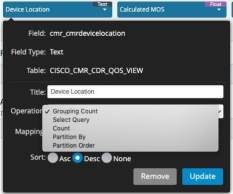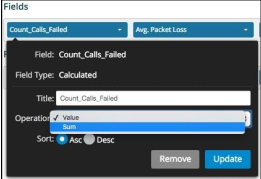Fields Details¶
The data elements in the Fields box have several analytic options depending on the context of the field and the desired functions, (e.g. Integer Field with a SUM Calculation). The options available are:
Text

If the extracted field is a text field then it will show “Text” in the Field Type. The Title is automatically populated with the field name from the log. This title can be changed to describe more accurately the data field. Next is an Operation box that provides two options:
Grouping Count - will group all of the same fields and count the number of times they occur in the data, for example: Field is Acme Trading and it occurred 35 times. The output will be Acme Trading count of 35.
Select Query - allows you to choose to output all records from the query without grouping them. Warning: This could result in a tremendous amount of data depending on the topic being analyzed. Example is a call table that could return millions of rows.
Count - will return the total count of the value. If there are 1000 occurrences of the value “350” the output will be 1000.
Partition By and Partition Order - These two functions are specific to our PostgreSQL database and allow you to show the most recent or the earliest entries in the data. They are utilized with the “Select Query” on the data set.
Integer

If the extracted field is an integer field then it will show “Integer” in the Field Type. The Title is automatically populated with the field name from the log. This title can be changed to describe more accurately the data field. Next is an Operation box that provides eight options:
Grouping Count - will group all of the same fields and count the number of times they occur in the data, for example: Field is the value “350” and it occurred 10 times. The output will be 350 count of 10.
Select Query - allows you to choose to output all records from the query without grouping them. Warning: This could result in a tremendous amount of data depending on the topic being analyzed. Example is a call table that could return millions of rows.
Count - will return the total count of the value. If there are 1000 occurrences of the value “350”, the output will be 1000.
Min - will calculate the minimum value that has occurred in the data and output that value.
Max - will calculate the maximum value that has occurred in the data and output that value.
Avg - will calculate the average value of all the data and output that value.
Sum - will calculate the sum of all the data and output that value.
Variance - will calculate the variance within the data and output that value. Variance is how far a set of integers are spread out, thus a variance value of zero indicates that all the values are identical.
Stddev - will calculate the standard deviation within the data and output that value. Standard deviation will quantify the amount of variation or dispersion of the data set. A value close to zero indicates that the data points are close to the mean or the expected value while a high value indicates that the data points are spread out over a wide range of values.
Partition By and Partition Order - These two functions are specific to our PostgreSQL database and allow you to show the most recent or the earliest entries in the data. They are utilized with the “Select Query” on the data set.
Calculate

If the extracted field is a pre calculated field then it will show Calculated in the Field Type. The Title is automatically populated with the field name used in the database. This title can be changed to describe more accurately the data field. Next is an Operation box that provides two options:
Value - will output the exact value of the calculated field, for example: The calculation is the count of all failed calls then the output will be that value.
Sum - will sum up all the values of the calculated filed, for example: The calculation is the call failure ratio then the output will be the sum of all of these values.
